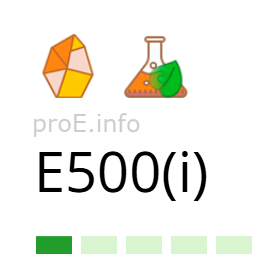
Other names for the additive (synonyms)
General Information
Additive E500(i) — sodium carbonate is a subtype of the group of food additives E500, commonly known as "soda". Sodium carbonate is often referred to as washing soda or soda ash.
Chemically, it is a sodium salt of carbonic acid with the formula Na₂CO₃.
On an industrial scale, sodium carbonate is mainly produced by the ammonia-soda (Solvay) process, involving the reaction of sodium chloride (NaCl), ammonia (NH₃), and carbon dioxide (CO₂). It can also be obtained by evaporating soda lakes or processing minerals such as trona.
In terms of its physical and chemical properties, additive E500(i) is a white crystalline powder or granules that readily dissolve in water, creating a strongly alkaline solution. It acts as a powerful acidity regulator (pH corrector).
In the food industry, additive E500(i) is used as:
- an acidity regulator to neutralize excessive acidity in products;
- an anti-caking agent in dry mixes;
- a component of leavening agents in the baking industry;
- a stabilizer in the production of cocoa and chocolate products.
Sodium carbonate is less commonly used as a leavening agent compared to sodium bicarbonate (E500(ii)), but it is employed in combination with acids in technological processes that require pH adjustment.
Read more about sodium carbonates and their effects on the human body in the main article about additive E500.